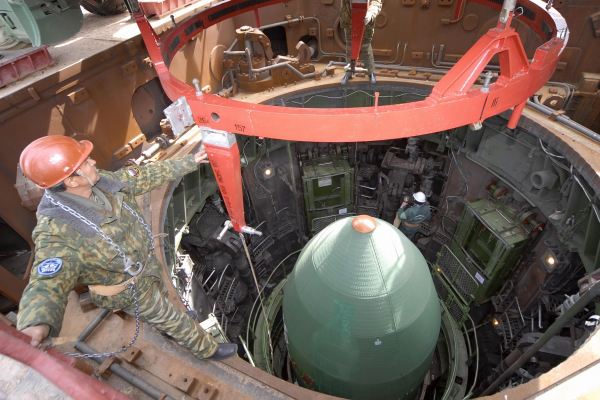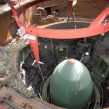
Moscow Adjusts Nuclear Modernization in Response to US Missile Defense
Publication: Eurasia Daily Monitor Volume: 13 Issue: 22
By:

Russia’s national security documents have long made clear the extent to which the state relies upon nuclear deterrence to guarantee the survival of the Russian Federation. Consequently, a key component in its military modernization is to overhaul the existing nuclear triad in order to ensure successful long-term nuclear deterrence. On January 12, the Russian minister of defense, Army-General Sergei Shoigu, during a conference call with the top brass, laid out the priority tasks for 2016. And at the very epicenter of these plans is the ongoing modernization of the nuclear arsenal. A critical feature of this process involves activating modernized regiments in the Strategic Rocket Forces (Raketnye Voyska Strategicheskogo Naznacheniya—RVSN). According to Shoigu, five of these were deployed to combat duty in 2015, and six more will be added in 2016 (Nezavisimoye Voyennoye Obozreniye, January 13).
Such targets reinforce the underlying message that Russia remains heavily reliant upon nuclear deterrence and intends, despite tightened economic times, to completely modernize the nuclear triad. This was further underscored by the National Security Strategy signed into law by President Vladimir Putin on December 31, 2015 (see EDM, January 7, 12, 2016). The document notes the vital role played by nuclear deterrence in Russian security strategy and fits a pattern that establishes the RVSN as the most important arm of service in the military—a position further reinforced by the 2014 Military Doctrine. Therefore, it is clear the defense leadership places high priority on fulfilling the target to activate a further six RVSN regiments in 2016 (in Irkutsk, Yoshkar-Ola, Novosibirsk, Kozelsk and Nizhny Tagil). This raises questions as to which systems this involves, the numbers of planned test launches, and what is driving the specifications of the modernized intercontinental ballistic missiles (ICBM) (Nezavisimoye Voyennoye Obozreniye, January 22).
Indeed, the modernization of the RVSN is not only about the number of active combat-duty regiments it can activate in any given year: coupled with target setting and planning for test launches, it has at its heart the very pride of Russia’s defense industry. That is, the newest heavy liquid ICBM—SS-28 (Sarmat)—with its first tests due to commence this year. The first Sarmat test is scheduled for the second half of 2016, using a silo launcher in Plesetsk (Archangelsk region). If successful, deliveries of the new ICBM may begin in the next two to three years. In mid-December 2015, the commander of the RVSN, Colonel-General Sergei Karakayev, announced the completion of the development work on Sarmat. The ICBM, replacing the RS-20V (SS-18 Satan) can deliver up to a ten-megaton warhead “anywhere in the World through both the North and South Poles” (Nezavisimoye Voyennoye Obozreniye, January 15).
The Sarmat, according to Russian nuclear specialists, is specially designed to overcome the United States’ ballistic missile defense (BMD) system and thus ensure the long-term durability of Russia’s nuclear deterrent. The heavy, liquid-based ICBMs make possible the delivery of warheads to targets not only using energy-optimal trajectories, but also to strike from different directions, including via the Earth’s Polar Regions. Major-General Vladimir Vasilenko, the former head of the 4th Central Research Institute of the Ministry of Defense, said that the multidirectional azimuth of approach of the new ICBM to the target will force the opposing side to provide perimeter defenses (Nezavisimoye Voyennoye Obozreniye, January 15).
Colonel-General Sergei Karakayev, in recent interviews, clearly shares the view that the Sarmat is a response to US missile defense and highly esteems its advances. Karakayev notes that Russia’s latest ICBM complicates the problem of an opponent’s countermeasures. The Sarmat has a reduced boost phase, smaller in length than previous generations of ICBMs, with a new coated casing and other components as well as a durable and lightweight design, combined with powerful engines and new control systems. Moreover, Karakayev ties the development of the Sarmat ICBM to US BMD, and suggests its design has been modified based upon analyses of the Missile Defense European Phased Adaptive Approach (EPAA) (Voyenno Promyshlennyy Kuryer, January 27).
The top brass and RVSN leadership is evidently convinced of the linkage between the Sarmat and ongoing US missile defense plans. It also forms part of the wider drive to modernize the nuclear deterrent. Karakayev stated that the RSVN is 56 percent modernized at present, and that Putin has set the target of reaching 100 percent by 2022 (Voyenno Promyshlennyy Kuryer, January 27). As part of the nuclear modernization, Karakayev assigns significance to the numbers of planned test missile launches. He reflected on the RVSN conducting seven missile test launches in 2015: one as part of combat training, two experimentally based, three further tests, and one to extend the existing missile life cycle. In 2016, Karakayev said that RVSN plans 16 launches, two based on extending missile life-cycles and the remainder either experimental or for training purposes (Voyenno Promyshlennyy Kuryer, January 27).
It is worth noting that there is quite a dichotomy between the announced plans for RVSN test launches and its actual launches, as has proven to be the case in recent years, despite the political-military support for nuclear modernization. Karakayev admitted only eight launches occurred in 2015, though 14 were planned. In the previous year, only ten launches took place despite the target set at 16; it is a consistent pattern that has emerged since the latest nuclear modernization was set in motion in 2008 (RIA Novosti, December 16, 2011; December 17, 2013; December 16, 2014; Lenta.ru, December 14, 2012).
Equally, the challenges involved in completing the nuclear modernization cannot be underestimated. The top brass places enormous hopes on the Sarmat, but to successfully introduce it will mean addressing some of the underlying defense industry problems that led to the sea-based Bulava debacle—a missile only now being gradually introduced. Achieving 100 percent modernization in the nuclear triad also depends on modernizing various high-technology and costly platforms in long-range aviation and in the Navy (Lenta.ru, January 28, 2016; TASS, December 25, 2015). Although the Sarmat project is driven by and influenced by Moscow’s response to US BMD, it seems that the target date for successful modernization is being pushed back, already from its original completion in 2020—now reset to 2022.




